Worcester class cruisers (1947)
 USA (1945-58)
USA (1945-58)
USS Worcester, Roanoke, Vallejo, Gary (CL-144-147) +6 cancelled Dec. 1945
The last US conventional light cruisers
Technically a class of WW2 cruisers as they were laid down before the en of the war in January and May 1945, studied from 1943, the Worcester class were a planned replacement for the 1940-designed Cleveland class. The Worcester were much larger at 17,997 long tons fully loaded, as much as Baltimore heavy cruisers, but they inaugurated a brand new automated artillery -in fact they were built around it-. The war ended well before launch, the class was cancelled with just two completed -Worcester and Roanoke- and when commissioned they found little use but in the Korean War in the classic gunnery support role, being decommissioned only by 1958, after barely a decade of service. The class largely has been seen as a failure. #ww2 #usn #usnavy #worcester #roanoke #koreanwar
Design of the class
Original idea and preliminary designs
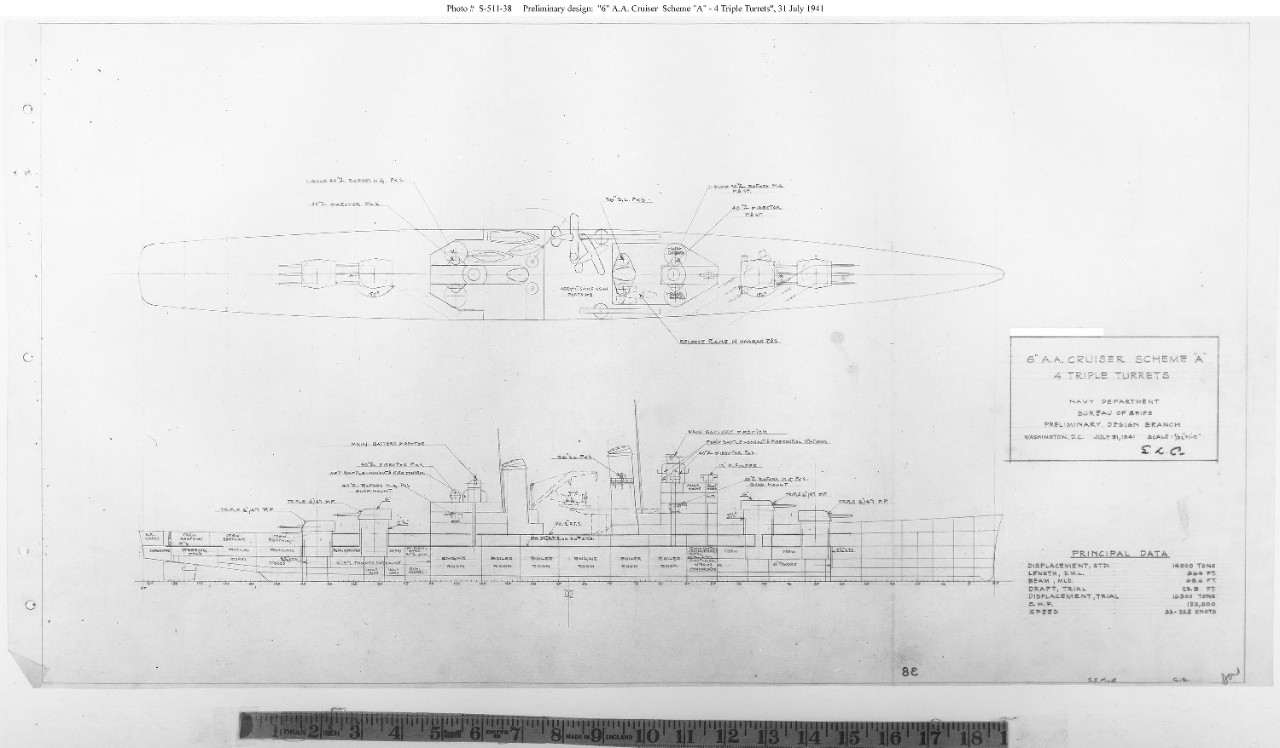
Buships preliminary design, 4×3 6-in AA cruiser, S-511-38 6 A.A. Cruiser Scheme A – 4 Triple Turrets Preliminary design plan prepared for the General Board during the development of a light cruiser with rapid-firing 6/47 anti-aircraft guns, which ultimately became the Worcester (CL-144) class. This plan, dated 31 July 1941, provides a 664-foot (waterline length) ship of 14,000 tons (standard displacement). It emphasizes speed and number of main battery guns, with reduced protective armor. Scale of the original drawings is 1/32 = 1′. The original plan is in the 1939-1944 Spring Styles Book held by the Naval History and Heritage Command. U.S. Naval History and Heritage Command Photograph.
These very “large light cruisers” of the CL-144 designed really were all about the twin 152/47mm automatic DP gun. They were not “invented” in 1944 but went well back to an original idea proposed by the Bureau of Ordnance as early as 1937… Only war priorities sidelined this development, which was delayed for years. It was originally intended for the CL-106 (Cleveland class) as designed, in 1939, with four twin turrets. But the whole system proved to complex to finalize and more classic triple ones were chosen instead, trading the original reload speed for more firepower.
The project was revived in 1941. The General Board Characteristics called by then for twelve 152mm DP guns (now that the hull tonnage was free) and as it evolved, no 5-in/38 secondary battery. Protection was originally to be limited to a very thick deck. Speed was to be of at least 33 kt to follow and escort the new fast fleet carriers.
Later, the Board wanted a return to a conventional side protection comparable to the Cleveland’s. It was retained for the finalized design early in 1944.
At the time, the Chief of the Bureau of Ships saw this design as a valuable alternative to the overloaded Clevelands. He observed also that even the new 5-in/54mm DP guns projected would not be enough to deal with the new guided bombs such as the “Fritz-X” or the Henchel antiship missiles introduced by Germany (showing thei worth in 1943 by sinking Roma) and presumably soon to be fielded also by the Japanese.
The perfect solution seemingly was a large 6-in (152 mm) explosive shell with a proximity fuse. The tests successes of the 6-in/47mm design eve, inspired the Bureau of Ordnance to develop an automatic 8-in version (203/55mm) suitable for heavy cruisers (such as the Des Moines design), not much larger than the Worcesters. The General Board recommended that the new seven new light cruisers programmed, CL143 to 149 were to be re-ordered as large heavy cruisers.
Production delays of this new 8-in/55 gun however urged the swap back to the more proven 6-in DP and the four ships ordered (CL144-147) had those. And two were completed.
The original design still included in 1944 no less than twelve quadruple 40mm Bofors, twenty 20 mm Oerlikon MGs until scrapped in the definitive plans approved in 1945 for an all-3-in/50mm battery and the four seaplanes and two catapults reverted to just two, and then never fitted while completing despite their presence on the final design.
Origins
The history of Anti-Aircraft Cruisers in the US Navy can be traced back before World War II, between the awareness of aerial attack and British conversions of their vintage C-Class cruisers into specialized AA escort ships. On the US side, the OMAHA class from 1923/1925 were also thought of for converions, but they were so lightly built and verging on unstability that they were soon seen as unsuitable. In 1938 the future ATLANTA class was designed, based on the new dual purpose 5-in/38 mounts promised by the ordnance. They carried sixteen of these and compared favourably to the British DIDO Class also planned at the time.
The Pacific war, in which aviation was soon the centerpiece of major engagements made the AA cruisers and ideal solution in these new kind of fleet actions on this immensity. The new USN AA Cruisers were assigned to the escort of fast carrier groups and also when battleships were not present, ensured an effective fire control radar and AA protection with eight commissioned during the war, from CLAA-51 to CLAA-98 and three more completed on a modified design postwar (plus many cancellations). There had been two losses in their class but overall, they proved the validity of the AA cruiser concept for the USN.
This pave the way for the CL-144 class, as the culmination of the thought on the matter. They were seen as a logical succession but at the same time, to the Clevelands as well, built like the CA-134 Class (Des Moines) around a large caliber but in that case dual purpose and very rapid firing gun mounting. The centerpiece of the design were to be six brand new 6-inches, 47 caliber in automatic twin mounts dveloped by the ordnance. They were the very first of their kind in the world.
About the Main 6-in/47 DP Mark 16 gun turrets
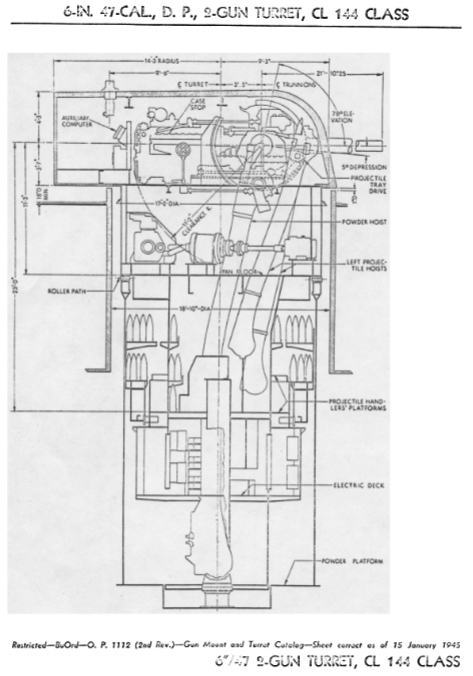
Plans of the CL-144 Mark 16 DP turrets.
The 6″/47 (15.2 cm) Mark 16 were the main guns used on the Cleveland (CL-55) class but common overall to the Brooklyn (CL-40), St. Louis (CL-49), and Fargo (CL-106) classes. Their design dated back 1932. The DP was an evolution (still Mark 16) proper to the idea of proximity fuses rounds, radar guided, so resting on a new high elevation mount and with an all-angle rapid-autmated loading system. The whole concept was already worked out in 1937 by the Ordnance.
It was essentially the same proven gun, but the mounting had a much better shell handling and loading equipment for an even faster rate of fire. It’s training and elevation rates amde the whole system fast enough to really be “Dual Purpose.” If the concept was ready on paper in 1939, the project intended for the Clevelands was never ready on time and unfortunately the CL-55 were completed with the proven system instead. In some ways, developments on this new artillry system precluded the more successful 8″/55 (20.3 cm) Mark 16 of the Des Moines class, which saw a much longer career.
The long development cycle was due to parasiting emergency with shifting war priorities. Officers of BuOrd were continually frustrated to have a proper ship to carry them. The first carriers were to be treaty-bound 8,000 tons AA/AS ships. The project was halted in 1940 as it was deemed unrealistic by BuShips. Next BuOrd proposed to mount them on the Montana class battleships, but ultimately the 5″/38 (12.7 cm) and 5″/54 (12.7 cm) designs were chosen instead. This bounced up again by mid-1941 when aligned to the latest aircraft developments. The war had these suspended again. The final cruiser carrier was not finalized until 1943 and so the mounts, which were ready since 1940, never saw action in WW2.
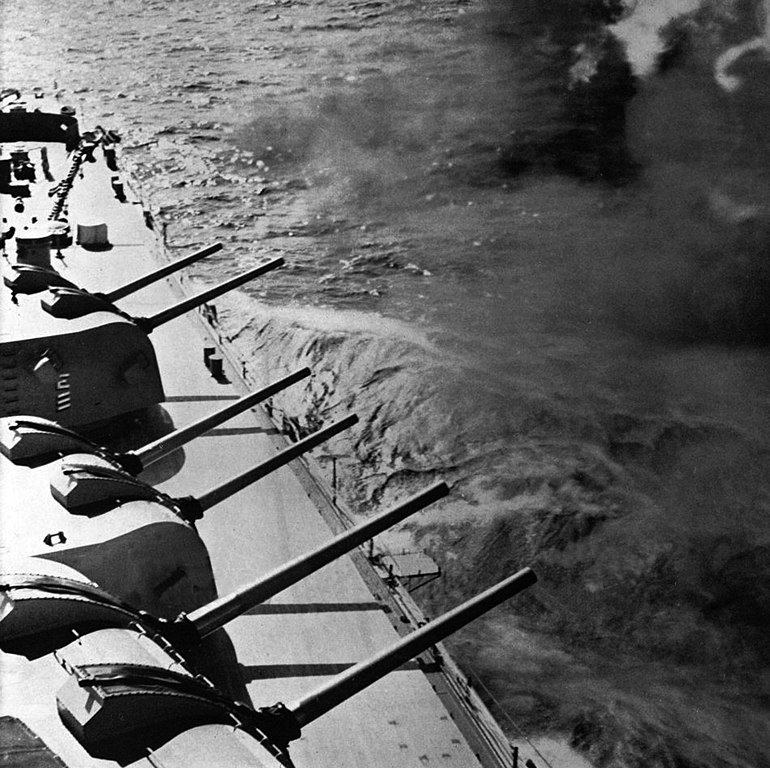
The turrets firing in 1957
However when deployed in 1948 on the Worcesters, they did not prove reliable in service, caught between unexpected issues resulting of the combination of this rate of fire and at any-elevation loading. The dual projectile hoist system for AP and HC/AA shells proved over-complicated and caused jamming. Plus the final turrets proved much heavier than expected, even though they were twin-mounts. These were 20% more than the triple turrets of the Cleveland/Fargo classes. Some in the navy were even dubious about the high size, displacement and cost of the Worcester compared to the two Atlantas, carrying 24 of the proven excellent 5″/38 guns at half the tonnage (and cost) of a Worcester. That’s why three were completed postwar, versus the Worcesters were cancelled.
Plans to replace these twin turrets with triple fully automatic DP mountings as the 8″/55 Mark 16 of the Des Moines, capable of 20-25 rpm per barrel (12 rpm for the CL-144) were cancelled in 1945.
All in all, although the Des Moines’s main artillery largely proceeded form the same idea, they were far more successful and “mature”.
Hull and general design
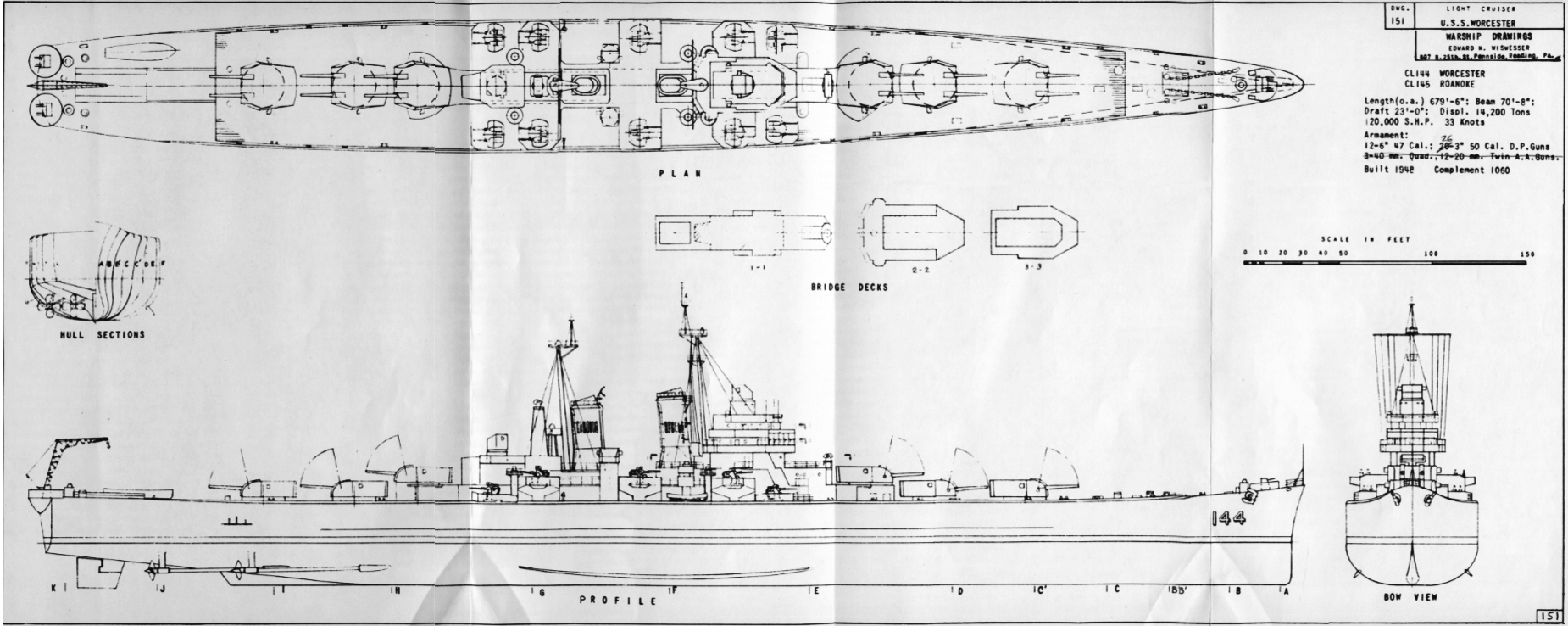
CL-144 final outline plans and elevation, dated 1948 as built. Note that the catapults had been removed at this point, and the two quad Bofors instead of the later installed single 5-in/50 mounts.
The Worcesters were much larger than the Clevelands, almost 2/5 more in displacement. With 14,700 long tons (14,936 t) (standard) compared to 11,744 and 17,997 long tons (18,286 t) full load compared to 14,130 ton in the orignal design.
The size was more generous also with 664 ft (202 m) at the waterline or 679 ft 6 in (207.11 m) overall versus 608 feets, 75 feets more. The beam was also more generous at 70 ft .5 in (21.3 m) versus 66 ft 4 in (20.22 m) or 4 feets more, preserving an almost 1/11 hull ratio ideal for speed. The draft of 25 ft (7.6 m) remained unchanged compared to the Clevelands.
These wartime measurements, free from any treaties, ensured the ships had some room for improvements, notably with AA armament or future modifications. They did not capitalized on this due their short career however (see later). The longer hull was naturally a consequence of the choice of six dual turrets instead of four triple. The hull had the same freeboard as the Clevelands, but it ended forward with a short raised section well forward of #1 turret to the prow, instead of a more gradual slope to increase seakeeping.
From one to two funnel stacks
The increase in crew despite the loss of all smaller AA calibers was of note. The nine gun mounts needed more crew (11 per mount), and two more machinery compartments boosted manning requirements. Each powerplant indeed required 176 feet of the total length of the CL-106 versus 200 on the CL-144 design. The Clevelands indeed had only two boiler rooms, each followed by an engine room. The CL-144 design had four boiler rooms, each pair followed by an engine room. The exhaust arrangement enabled a return to two small stacks rather than a large one on the redesigned late Clevelands. Early original plans showed one big stack as well as contract plans but the more detailed design went for small stacks.
Protection and internal organization
Following the usual U.S. practice in cruiser construction, the inner bottom followed the curve up the sides to the 3rd deck forming fuel tanks abreast and under the machinery spaces, as the plotting compartments forward and aft of these. The armored 3rd deck with its heavy transverse bulkhead ends and side armor formed the upside-down “armor box” over these eight ASW protection compartments. The lower and narrower armor boxes protecting the magazines and steering gear, in STS. The pilot house was also covered with extra armor. Although it was planned, no conning tower was fitted in the end to free weight and inscrease stability.
Protection was revised to have the ships proof against 6-in shells and the decks proof against 1000 Ibs (454kg) SAP bombs from any altitude and same weight AP bombs dropped from below 7,500 ft (2,300m). There was a separate ‘bomb deck’ above the main armoured deck to disseminate energy, as in battleships and late heavy cruisers.
Superstructures
It comprised above the main deck a first level with shops and offices amidships, CPO and crew’s mess aft, wardroom, and 2nd deck with Officers accomodations, a 3rd deck with almost all crew berthing. The command tower’s 3rd deck was the Flag and Signal Bridge, the 4th level was the Navigating Bridge and 5th level the forward Air Defense Station.
The superstructure was squeezed between the main guns guns forward, the broadside secondary mounts in width, dotted with directors and only 14’6″ wide in general (). It housed only the Admiral’s bridge forward, Capitain bridge forward on 1st level, Chief of Staff forward on second level with cabins for both the Capitain and Admiral forward on the 3rd level. The Captain’s plot room was located on the 4th level aft of the pilot house and the CIC was down on the first platform, below a STS armor stray.
Armour protection layout
It had nothing revolutionary but comprised the following scheme:
Main Armour Belt: 3–5 in (76–127 mm), abreast machinery 4.4m high. 3-in at lower edge on 0.6-in (16mm) STS plating.
Armor deck: 3.5 in (89 mm) same for flat section and slopes.
Turrets: 2–6.5 in (51–165 mm) Forward part sloped. 76-51mm sides, 76-51mm rear 102mm crowns.
Barbettes: The walls were 5 in (127 mm) thick down to the armor deck.
Conning tower: 4.5 in (114 mm) in the iriginal design. It was seen by engineers as an obsolete feature and eliminated when completed.
There was also a stray or STS armor over the magazines and steering compartment, as well as the CIC:
Magazines: 3.6-in (93 mm) bulkheads fore and aft,
Machinery and magazines: 5-in to 2-in (127-51mm) bulkheads.
ASW compartimentation was the same as the Clevelands, with a three-tiered layer but a relatively poor depth to face an IJN torpedo warhead. It was designed to delay the flooding, helped by the localization of the engines and boilers in separare rooms. There were 2-in underwater belts abreast the fore fourth magazines. The Underwater belt over the aft magazines were 5-in thick.
All in all, this was roughly comparable to the Cleveland scheme, not much innovation there, although better thought out, especially against bomb hits, both AP and SAP.
No change was required during the early cold war with the Soviet plans for new large light cruisers of the Sverdlov or the planned large heavy cruisers.
Powerplant
The Clevelands counted four geared steam turbines based on four shafts, fed by Babcock & Wilcox boilers rated for 100,000 shp (75,000 kW) for 32.5 knots (60.2 km/h; 37.4 mph).
The larger Worcesters needed a better powerplant, on the same four screw propellers for four geared steam turbines fed by Westinghouse 620 psi boilers for an output of 125,000 Horsepower, for 33 knots. They had four Babcock & wilcox bosters (double-ended) working at 610 PSI, mated to four General Electric geared steam turbines separately in forward outer, and inner engine rooms. The main propellers shafts were driven through double reduction gears. The astern turbines consisted of elements in each end of the Low pressure turbines.
For auxiliary power, they were four General Electric 1500 KW 450 volt AC steam turbine driven nain generators were located in each fire room. There were two General Electric 500 KN 450 volt AC energency generators also, driven by 710 H.P. General Motors diesel engines.
As for the range, the Clevelands were capable of 8,640 nmi (16,000 km; 9,940 mi) at 15 knots (28 km/h; 17 mph) and the Worcesters a but less, 8,000 nmi at 15 knots based on 2,400 of fuel oil capacity.
Armament
The real game changer in the design was the adoption of a new type of 6-in guns/47 as a kind of heavy dual purpose ordnance. The Worcesters, which basically were just carriers for this new and promising artilley system, aimed at becoming a “universal” type of aircraft carrier escort (conventional) cruiser, replacing both the Clevelands and Atlanta (so AA cruisers) in one package.
However of the mao armament was fixed early on, it was still unsure for the secondary/tertiary armament. In the early discussion phase, back in 1943, it was agreed that the rest would be “classic”, centered around twelve (six twin) DP 5-in/38 turrets as dual purpose completement, two per side and one each end of the same lenght superstructure despite the longer hull (to arrange the six main turrets in line), and quad, twin 40 mm Bofors/70.
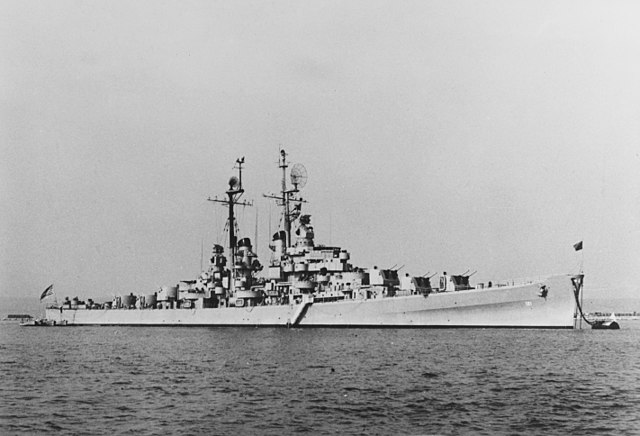
USS Fresno of the late Atlanta class (postwar completion). Upgraded, they provided almost the same firepower as the Worcesters, and much faster (5-in. versus 6-in).
It was recoignised at that stage already the 20 mm Oerlikon was too weak and an all-Bofors armament was retained.
However the Bureau of Ordnance proposed an alternative and more radical solution in 1944: To replace both the Bofors and 5-in/38 by a new universal caliber in development, the 3-inch/50 guns. Given the caracteistics of bot the new guns and guidance system, it was accepted.
When approved for construction, the final design integrated only two calibers, which was quite radical for a cruiser at the time and made some uncomfortable in the admiralty, for good reasons. If one or the two new weapons systems lacked what was promised, the ship’s self protection could be halved.
Main: Six dual 6-inch/47-caliber guns
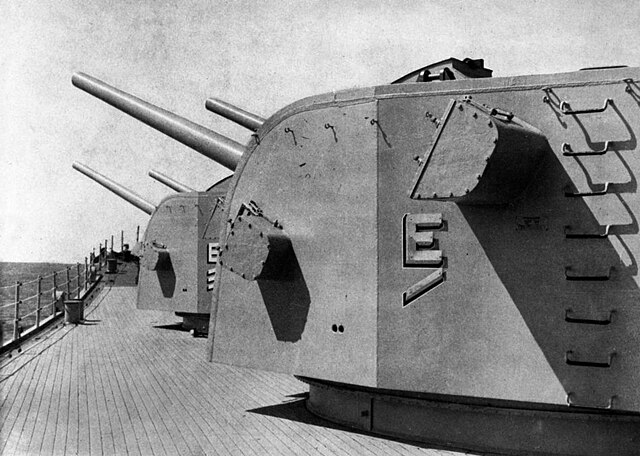
The biggest change from a main armament of CL-106 Class for a 4x 6″ triple mounts to the 6×6″ twins necessitated a longer hull and required an increase in horsepower to make the same 32 knots.
The final mounts entered Service only in 1948, although they were ready in 1943. The Gun weight was 6.5 tons (6.6 mt) with a 282.3 in (7.169 m) barrel.
Firing at 12 rpm, they could be supplied with the same rounds as the regular Mark 16 guns, thus the AP Mark 35 Mods 11 (130 lbs/59 kg), HC Mark 39, Illum Mark 39/41, Window Mark 39, Target Mark 36/37. Approx. barrel life was 750-1,050 rounds and ammo stowage of 403 rounds per gun, so 4,800 rounds, which was enormous for such caliber.
The 105 lbs. (47.6 kg) HC was the fastest around, at 2,665 fps (812 mps) muzzle velocity. It could land on a target at 26,118 yards (23,881 m)/47.5° for the AP shell. Against aicraft the ideal range was 23,483 yards (21,473 m) at 46.6°.
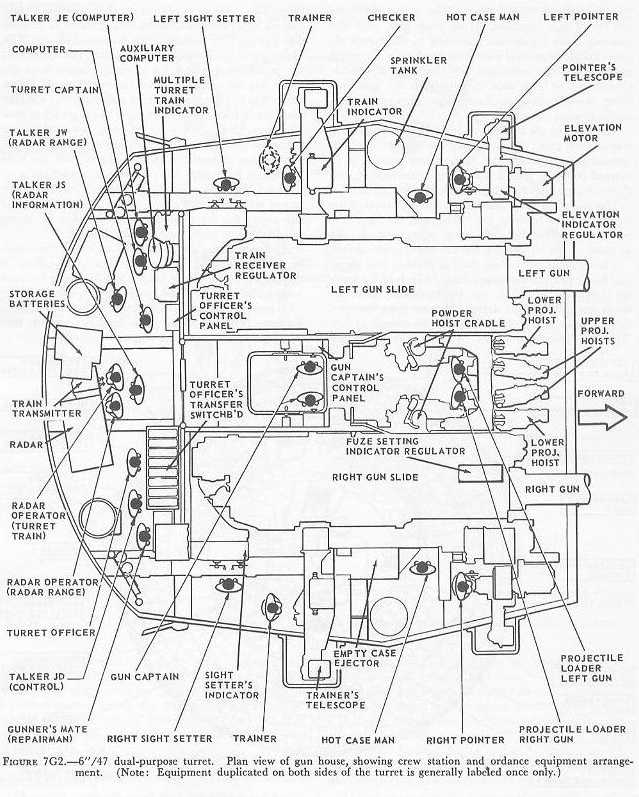
Turret’s top view cutaway, showing the location of crew operators and complicated arrangement due to the dual round/dual nature of the whole system.
The turret was the heaviest, largest “light gun turret” ever put at sea: Weighting 208.5 tons the mounts could elevate -5/+78 degrees and load the same, at an elevation Rate of 14.8°/sec. and train +150/-150 degrees at 25°/s. Each turret neded a crew of 21 men, which was also quite extensive compared to the previous triple ones, explaining the larger crew (hence higher maintenance operational costs).
Secondary: 24x 3-inch/50-caliber
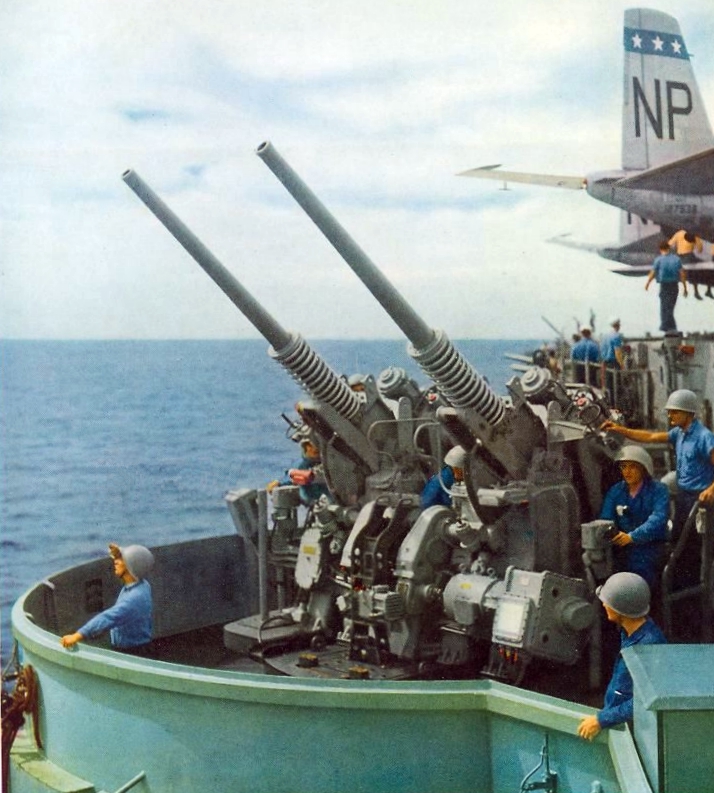
The secondary AA artilley comprised 11 × dual 3-inch/50 and two single 3″/50 caliber Mark 34 guns.
The dual mounts were designed to replace the 40 mm Bofors, and deal more decisively with Kamikaze attacks, shooting down plans with one or two hits, more accurately and in a shortest span. They used a semi-automatic power-driven automatic loader and existed in a single 3”/50 Mk.27 mount or quad/twin (Mk.33/34) mount. They used an open-base-ring (no turret) for a 360 at 30° sec. revolving time, 15-85° elevation at 24°/s. The on-mount magazine was assisted by two loaders with a total crew of 11. Aluminum and fiberglass weather shields could be optionally installed.
The 3-in/50 Mark 22 used a proximity fuze, fire-control radar for a 50 rpm per barrel for 2,700 fps (823 mps) and 14,600 yards (13,350 m)/30,400 feet (9,266 m) range/Ceiling.
They were located on either side of the superstructure, two outer ones at deck level and three on upper deck positions. There was one more at the prow, and two single aft. There was a plan to install another twin mount straddling over the anchor chains as for the CA-134 design but it was omitted and the after mounts were only singles because of lack of room in way of the aircraft crane.
The 3″ magazines in the hull which were too close to the 6″ turrets wells #3 and #4, were surprisingly small. The electric hoists bringing ammo up to the main deck into small deck houses abeam or near the 6″ barbettes were thus passing through the three large ready service rooms located amidships on both sides. These were all crowned by a 3″ twin mount, as well as the end rooms which served mounts at main deck level. Small magazines at the 2nd deck level served the end 3″ mounts. Of these, a twin was mounted at the narrow bow, just forward of the anchor gear. The deck gang must have been rather cramped.
Detailed specs.
ASW armament:
As a side note, they were also completed with an etxensive ASW defense suite: Four HA/LA DCTs and two LA/DCTs arranged in lozenge disposition.
Air Group
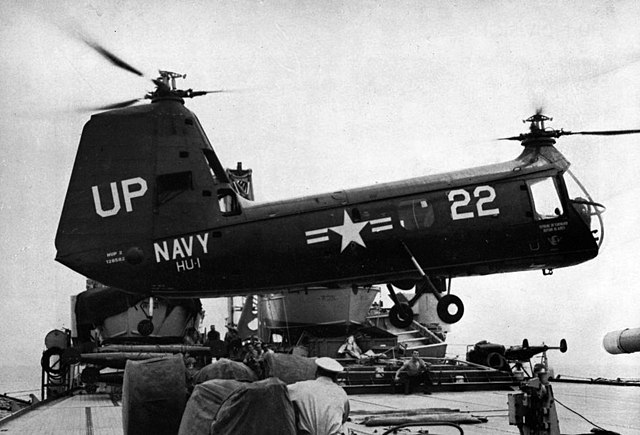
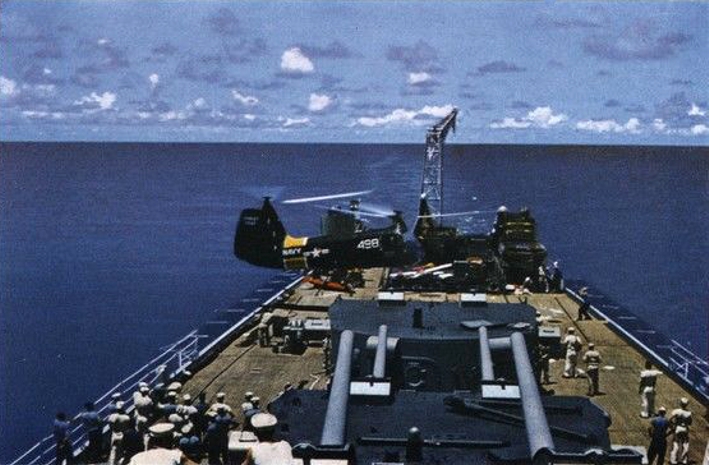
Piasecki HUP-2 Retriever landing or taking off on Worceseter and Roanoke.
As initially designed in 1944, the Worcesters still had the same system as the Clevelands/Baltimore classes: One hangar and lift to operate up to two seaplanes of the Curtiss SC Seahawk Type, two catapults aft and an axial poop service crane. At that stage radars could provide accurate fire, but seaplanes were still thought as useful for long range artillery spotting, reconaissance beyond radar range, laison and other tasks. Since the Sikorsky S4 produced in short numbers was experimented in combat also in 1944, some in the Navy saw a possible better solution on the long run. However the speed and range of these early helicopters was very limited.
The two catapults however were removed before commissioning along with the two intended seaplanes, stowed in the below decks hangar, wiich was offset to port. It was used for boats instead. Two were stowed on the closing sliding hatches above. Only the crane was left, as it was handy to lift loads to be stored inside the ship via the lift. The hangar was as large as the full width of the ship, one compartment long as on the CL-106 (Cleveland class), instead of two as on the CL-40 design. During the war seaplane space was reduced as ofter one of the compartments was separated to make for more crew space.
The ships saw their early years without any aircraft type, solely relying on their radars. In 1950 the Piasecki HUP-2 Retriever, first multirole, two-shaft medium naval helicopter started to be depliyed on all USN ships. The two Worcesters were not exception and gat their own two helicopters for a variety of missions during the Korean War. They seems to have been kept until their retirement, but exposed to the elements as they did not fit inside the hangar.
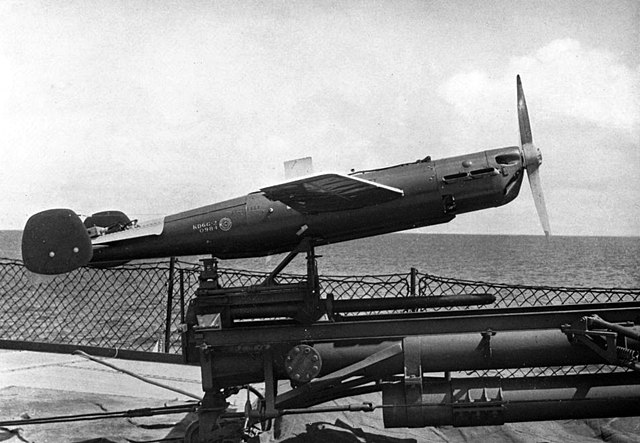
A Globe KD6G-2 Firefly drone being tested on USS Worcester in 1957. It was a target drone, used for gunnery practice, launched from a ramp.
Sensors & Fire Control
The Worcester were no different from previous ships: Four Mark 37 gun directors were installed in a centerline one atop the forward and aft superstructures, plus each side amidships. On the previous ships they were used for the 5-in turrets only and to direct anti-aircraft fire, whereas the special Mark 34 were iused as the main gun directors. This choice had severe consequence for the rest of their career as they had been optimized for AA fire at the expense of anti-surface fire.
In their place, designers choosed to install Mk 13 radar antennas with optical rangefinders mounted aft of turret 3, and just aft of the mainmast. They still had four large Mark 56 gun directors one each side of the forward and after superstructures, and with nine of the smaller Mk.1 directors provided data for each 3 inches AA mount. The 1944 experience of Kamikaze atack had been a deteminant factor and ths has not been changed after 1945. The specification was that guns were to use only large size proximity fuzed projectiles.
Initially their received the SR-2, SR-6, SG-6, SP-2, as well as four Mk 25, six Mk 27, and four Mk 35 radars associated to the fire directors.
However later the ships were modernized. In 1955 they both had six twin 20mm/70 AA guns added, as well as the new SG-6, SP-2 radars and SPS-8 radars.
They gradually received a brand new radar suite comprising the following in 1963 when discarded:
AN/SPS-10 surface-search radar: 2D Freq C Band PRF 650 Hz Bwt 1.9° × 16°, Pwt 1.3 µs, Pw 280 kW
AN/SPS-6 air-search radar: 2D Freq L Band, Range 130-260 km (70-140 nmi) pw 500 kW
AN/SPS-8A height-finding radar: 2D S-Band 1-2 MW, Bwt 2-μs, Pwt 450 and 750 Hz
AN/URD-4 radio direction finder: Freq 400 mc, Bwt 50kc, 100 MW More
AN/URN-3 TACAN: Src
AN/SLR-2 ECM Receiver: Countermeasure system. More
Mark 56 fire-control system: Radar tracker, Freq X-band PRF 3,000 pps Bwt 2, Pwt 0.1-0.15 μs Range 27 km (14.6 nmi)/prec 9m (10 yd), 50 KW.
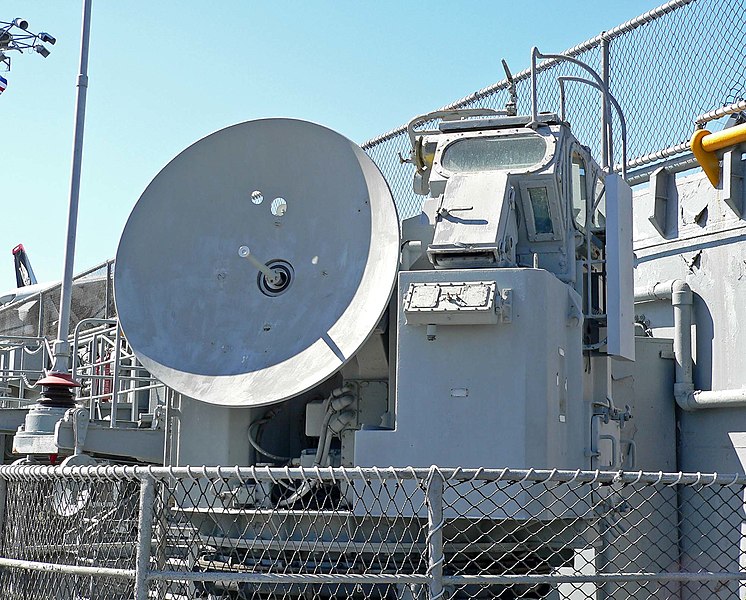
Mark 56 Gun Fire Control Director.
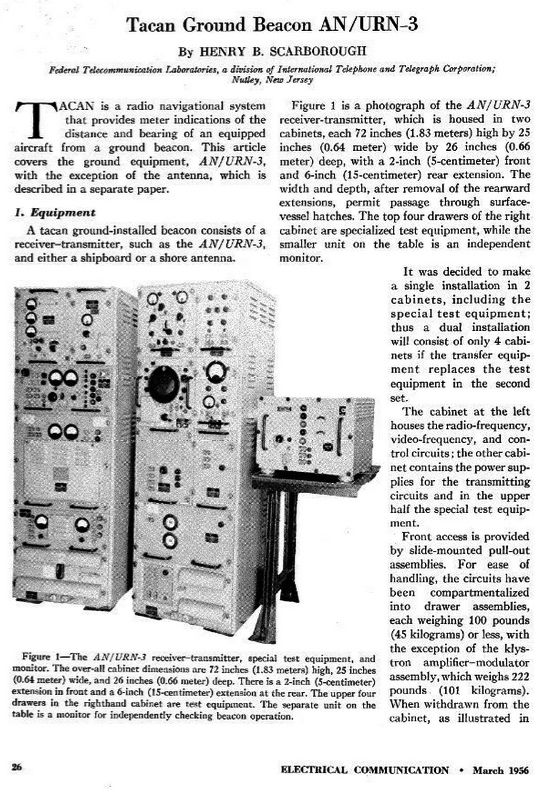
The TACAN AN/URN-3 Ground Beacon
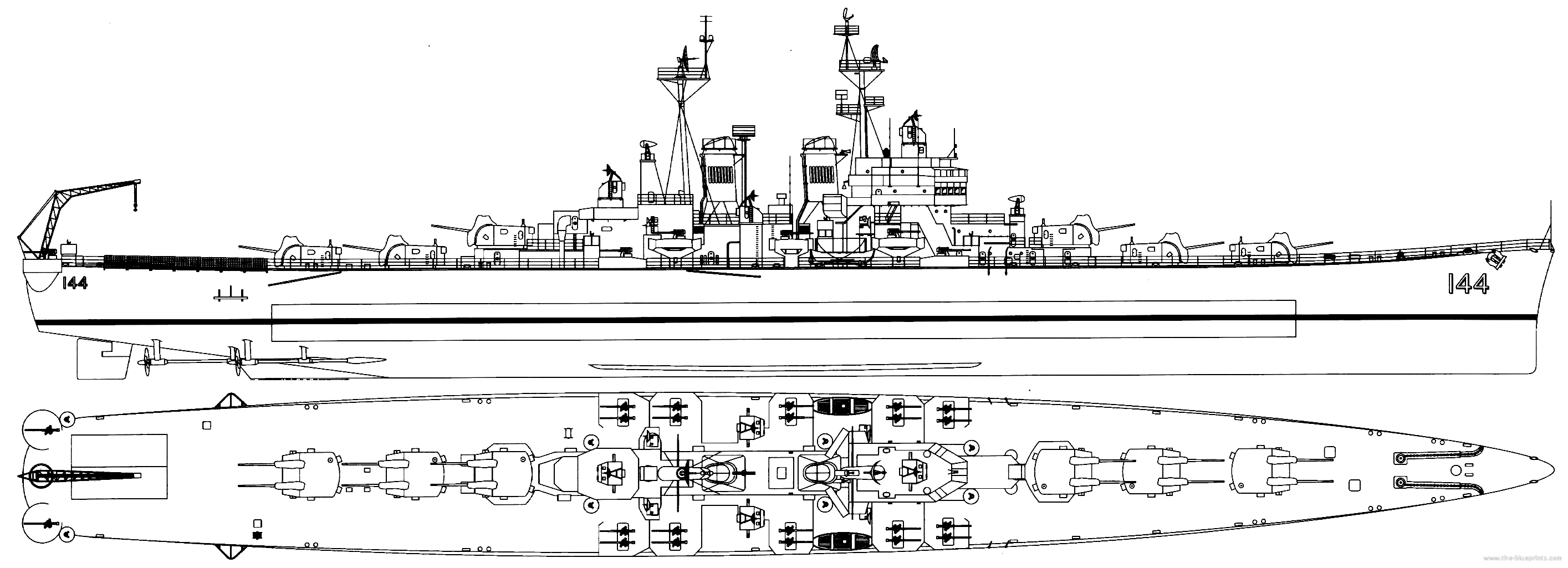
As built, 1948

In 1963. Both ships were modernized the same way
⚙ specifications |
|
| Displacement | 14,700 lt standard, 17,997 lt FL |
| Dimensions | 664/679 ft x 70 ft 0.5 in x 25 ft (207.11 x 21.3 x 7.6 m) |
| Propulsion | 4 GE GS turbines, 4 West. 620 psi boilers, 125,000 Horsepower |
| Speed | 33 knots |
| Armament | 6×2 6-in/47, 11×2 + 2×1 3-in/50 AA |
| Sensors | See notes |
| Protection | belt 5 in, deck 3.5 in, turrets 6.5 in, barbettes 5 in, CT 4.5 in |
| Crew | 1,560 officers and enlisted |
Construction and general Assessment
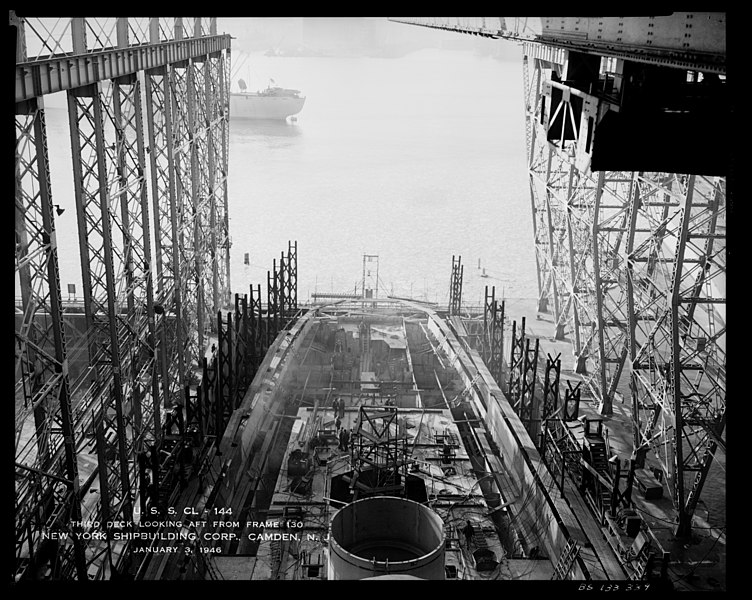
Worcester in construction, 1946
Worcester was laid down on 29 January 1945 at Camden, New Jersey, by the New York Shipbuilding and Drydock Corp., and launched on 4 February 1947. Sponsored by Gloria Ann Sullivan, the daughter of Mayor F. G. Sullivan of Worcester, Massachusetts, she was commissioned at the Philadelphia Naval Shipyard on 26 June 1948.
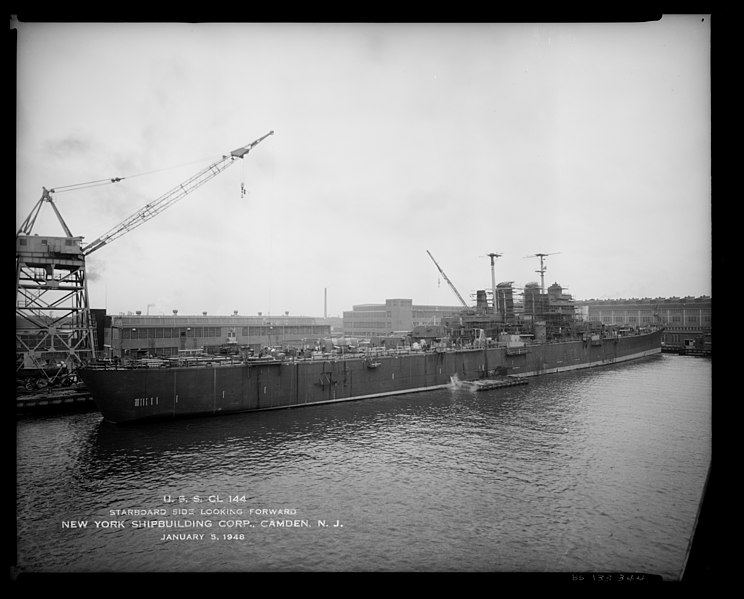
Completion of USS Worcester in 1948.
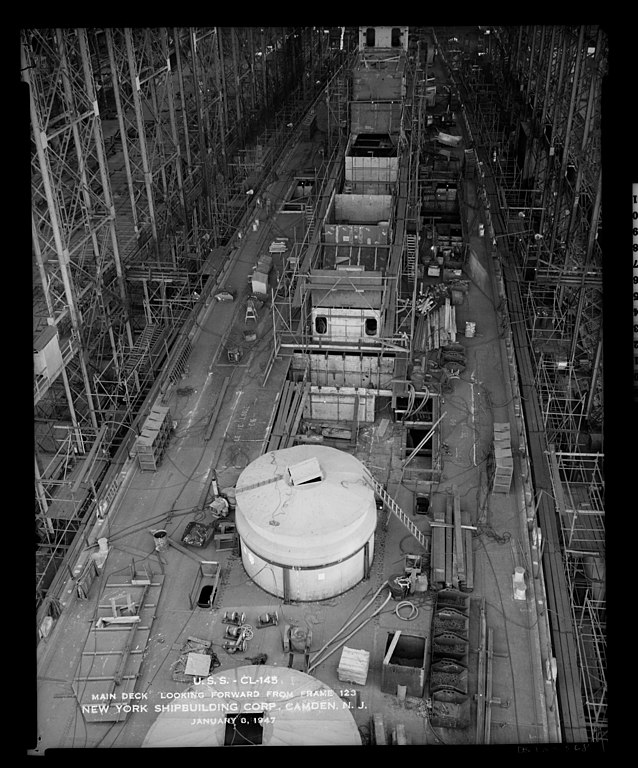
Roanoke in construction, 1946
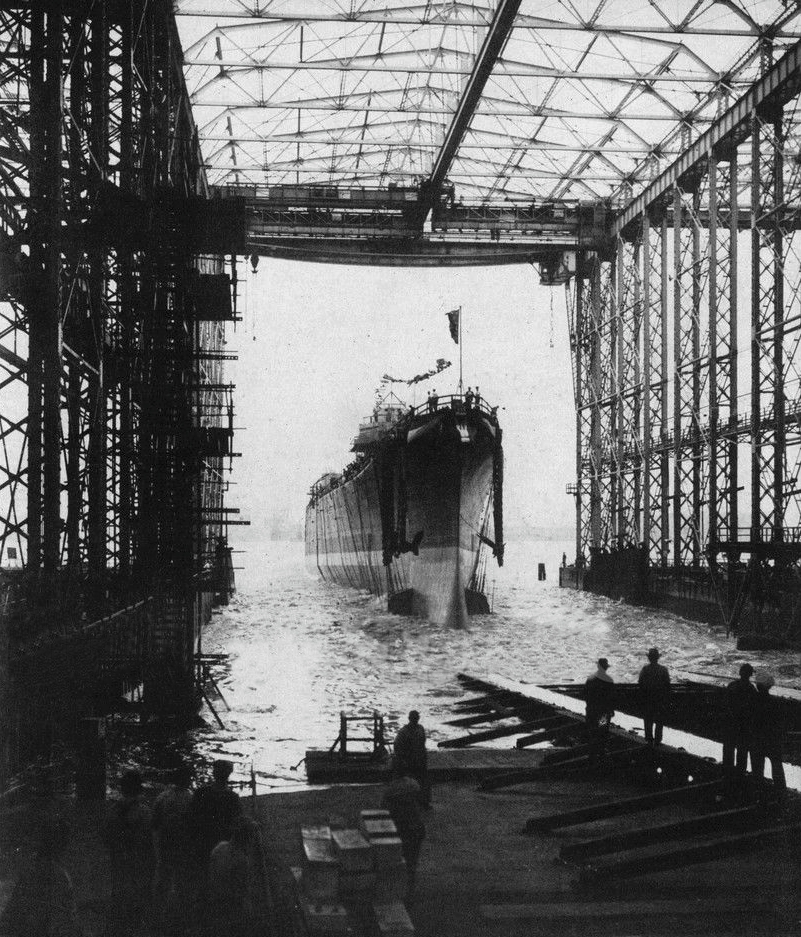
USS Roanoke’s launch on 16 June 1947 at Camden NyD
Roanoke was laid down on 15 May 1945 by the New York Shipbuilding Corp., Camden, New Jersey; launched 16 June 1947; sponsored by Miss Julia Ann Henebry; and commissioned at Philadelphia 4 April 1949.
The Worcester in the end combined destroyer maneuverability with cruiser size and on paper their main battery could deal with both surface targets and aircraft with long and medium range conventional artillery. The design however in 1955 was already largely considered a failure. This was due to a combination of factors:
-The main armament achieved in reality 9-10 rpm, lower than the 8-inch and unreliable.
-The fire control was optimized for anti-aircraft fire rather than surface action or naval gunfire support unlike the Des Moines class, and found less use in the Korean war context.
-Their crew was more extensive than the Cleveland class, and their AA firepower not that impressive compared to the high volume of fire procured by the updated Juneau(ii) class. They were twice heavier and costier to operate.
-The 1950s first jets already made their DP artilley obsolete.
-Their hull proved not adaptable enough to carry missiles and so they were scrapped instead of being converted.
 USS Roanoke (CL 145)
USS Roanoke (CL 145)
Following a shakedown cruise in the Caribbean, USS Roanoke started maneuvers with the Atlantic fleet as part of a Battleship-Cruiser Force. On 6 January 1950, she joined the 6th Fleet in the Mediterranean, her first long overseas deployment. She was back home in May and went on alternating home service, rest and maintenance with 6th Fleet deployments punctuated with western Atlantic exercises until the summer of 1952. She made that year a midshipman’s cruise to Europe and the Caribbean. She repeated this yearly, alsways as par of the Battleship-Cruiser Force, U.S. Atlantic Fleet. By the fall of 1955 she completed her 6th Med Tod and was prepared to be transferred to the Pacific Fleet, having seen nothing of the Korea War.
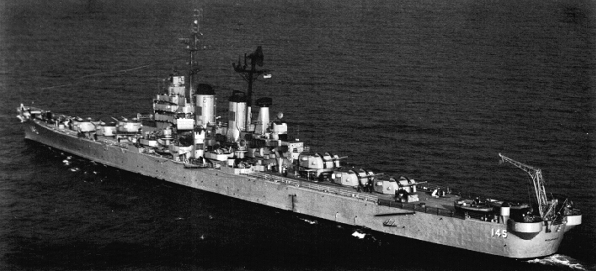
Roanoke Underway circa 1949

Roanoke in early 1949
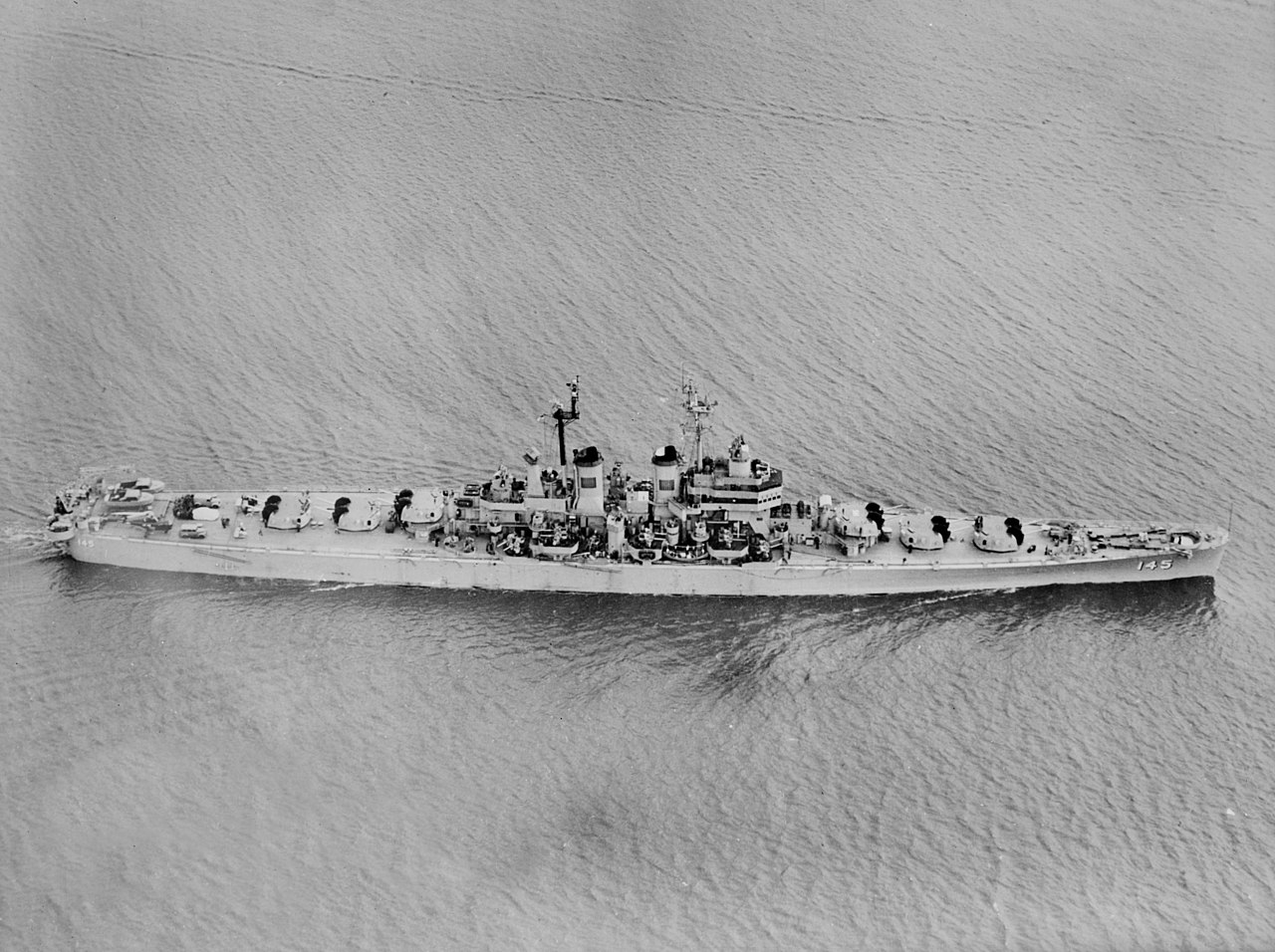
Roanoke underway Jan 1950
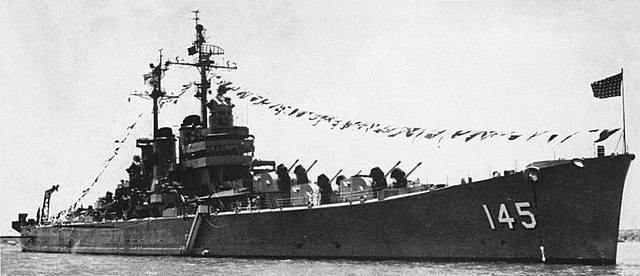
Roanoke off Famagusta, Cyprus, 22 Feb. 1950
On 22 September 1955, USS Roanoke departed Norfolk, went through the Panama Canal to join her new Homeport, Long Beach, Ca. She made from there nine Naval Reserve cruises alternated to three WestPac (Western Pacific) cruises from May to December 1956, September 1957 to March 1958, and September to October 1958. After a cushy and uneventful life, due notably to her high maintenance costs and little use at the age of missile, she was decommissioned 31 October 1958.
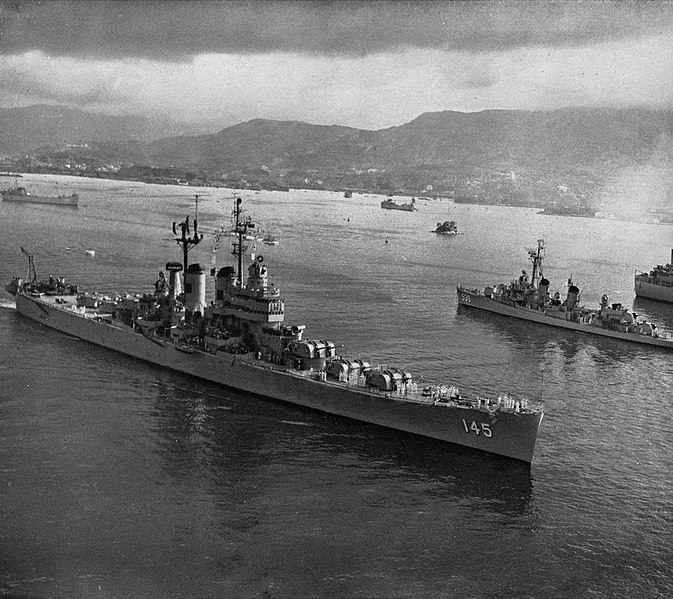
Roanoke off Sasebo 1956
Berthed at Mare Island in 1963, she was eventually sold to Levin Metals Corp. San Jose, California, on 22 February 1972. Her bell has been saved and is now on display outside of Elmwood Park, Roanoke Public Library. A model of the ship can be seen also at the Virginia Museum of Transportation in Roanoke.
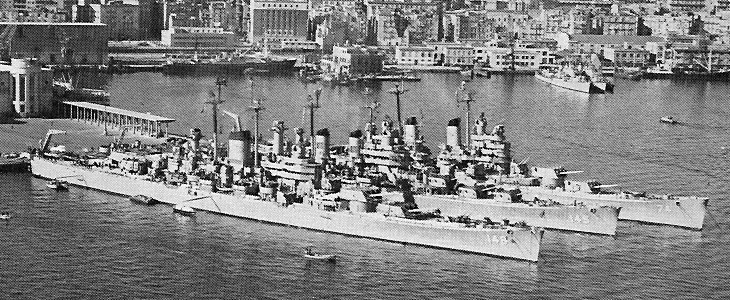
USS Roanoke in the the reserve, with CL-148 New Port News
 USS Worcester (CL 144)
USS Worcester (CL 144)

CL-144 Worcester in completion
USS Worcester had a more interesting career than her sister ship, that’s why we will take more time on her: After completion, sea trials, shakedown and fixes, USS Worcester was assigned to Cruiser Division 10. She spent a year after fitting out and shakedown, availability training off the eastern seaboard. By the summer of 1949, she took part in her first major training exercises in Guantanamo Bay. She visited Kingston in Jamaica. Next, she departed for the Mediterranean and 6th fleet from Newport, Rhode Island her home port on 6 September. From Gibraltar she visited Malta, Bizerte, Golfe-Juan, Argostoli, Phaleron Bay, İskenderun, Trieste and Venice, then back to Gibraltar, punctuated with exercises and maneuvers with the local fast carrier task force, USS Leyte and with the heavy cruiser USS Des Moines. She was back to Norfolk on 10 December.
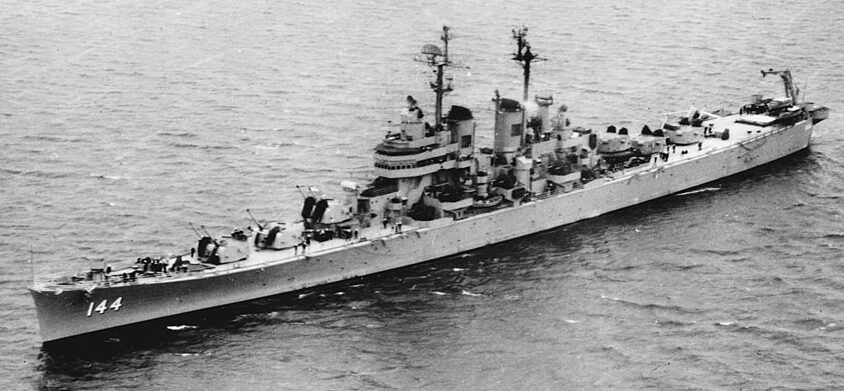
USS Worcester underway in November 1949.
In 1950 she trained off the eastern seaboard Norfolk-Puerto Rico stopping at Philadelphia, and back to the 6th Fleet deployment, arriving in Lisbon on 13 May, visiting Augusta, Sicily, Bizerte, Genoa, La Spezia, Golfe Juan, Phaleron Bay (20 July) and received there ordered to sail to the Far East via Suez as the Korea war started. She departed on 27 July with DesDiv 21 (USS Fred T. Berry, Keppler, Norris, and McCaffery) via Port Said and arrived in Colombo to resupply on her way in early August.
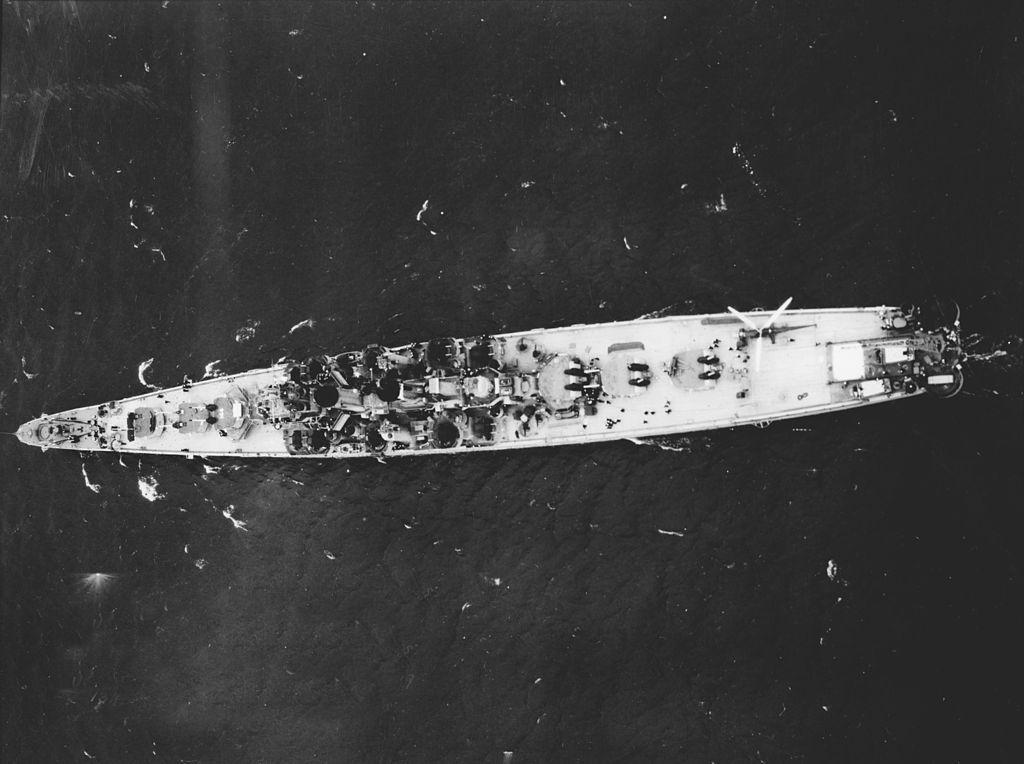
Aerial view of USS Worcester in 1949

Worcester underway in November 1949
Departing via the Malacca Strait, Bashi Channel, they arrived at Buckner Bay, Okinawa on 19 August, and en route stopped briefly to survey the strait of Formosa. She refuelled from USS Navasota, departing on 20 August for Keelung, Formosa (Formosa Patrol) until 26 August. She then joined TF-77 (Pacific fast carrier task force, USS Philippine Sea, Valley Forge) in the Yellow Sea, off the coast of Korea.
She started operations against enemy targets in the central and southwestern Korea, covering air strikes, screening them against possible air attacks. She carried a helicopter used for plane-guard duty and SAR.
On 4 September her radar picked up an unidentified contact and the scrambled Vought F4U Corsairs from Valley Forge spotted an unknown twin-engine bomber they shoot down 49 miles off TF 77.
The following day general quarters were ringed at 11:08 and she started manoeuvering at 20 knots whe picking another unidentified plane, furing for the first time her 6-in guns in anger at the approaching bogey. But she stopped as it turned out to be a firendly British Short Sunderland on patrol.
In September she later transferred her helicopter to USS Philippine Sea, starting practicing anti-aircraft firing. She resupplied at Sasebo, Japan later.
She was back with TF 77 on 11 September as the large UN amphibious assault was performed at Inchon.
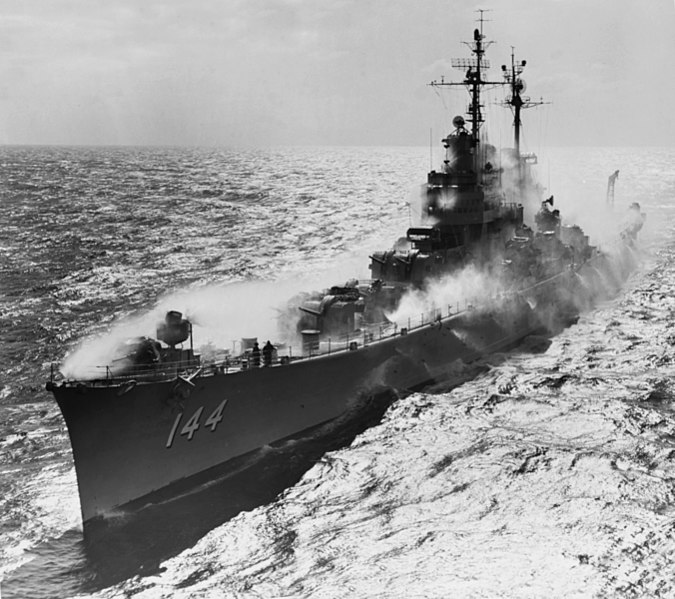
USS Worcester testing her anti-nuclear radiaton washdown system in July 1954
USS Worcester supported the Inchon landing not with ground fire but still by screening the fast carrier task force, but on 20 September she made her first shore bombardment mission, detached with TG 95.2 off Pohang Dong, with USS Helena, just 3 miles off the east coast of Korea, north of Pohang Dong. She also patrolled the coast and relieved Helena in her fire support duties on 24 September as the latter resupplied to Sasebo. Worcester used her helicopter for ASW patorls, and she started firing at 08:05, on troop concentrations, directed by Korean Military Advisory Group personnel ashore. She achieved pinpoint accuracy thanks to this guidance. She was relieved by Samuel N. Moore and resume patrols with USS Brush. In June she resumed this routune of fire support.
By 25 September, she used her helicopter for artillery spotting in fire support for the advancing UN forces. She patrolled by night a stretch of coast between Yonghae and Utchin and on 26 September fire support ceased as troops were too far away inland. USS Brush hit a naval mine off Tanchon an Worcester sailed out to help, replaced by Samuel N. Moore o station. Running at 27 knots she found USS Brush down by the bow, with a 3-degree port list with 5 dead and 30 injured, boading her to assit. The latter was saved by its safety team and after the wounded were evacuated to Japan, the crippled destroyer escorted by USS De Haven went to Sasebo on the 29th.
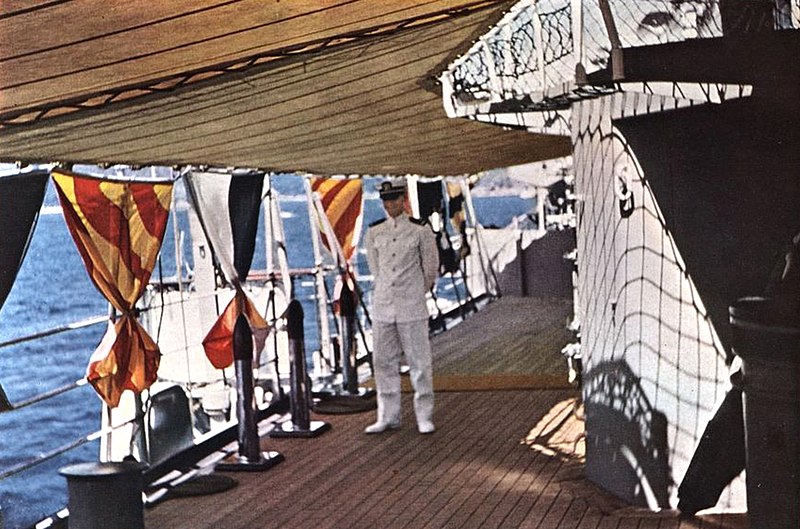
USS Worcester in full dress regalia, Sasebo, for the Admiral swap as flagship.
The cruiser was immediately back in Korean waters, resuming fire support and screening, and on 1 October joined the blockad south of the 41st parallel, deploying her helicopter for ASW and anti-mine patrols. Screening destroyers found and destroyed otther drifting mines. As flagship for TG 95.2, she hoisted the mark of Rear Admiral C. C. Hartman. Worcester became flagship also of Rear Admiral Allan E. Smith, from TF 95. She screened minesweeping operations at Wonsan and supported the 3rd ROK Army Division.
She saw her escort augmented by HMS Cockade, HMAS Warramunga, and HMCS Athabaskan, HMS Ceylon and USS Helena, Rochester, Herbert J. Thomas, and Maddox and from 12 October, USS Missouri.
At 11:50 a shell landed 5,000 yards (4,600 m) off the task force, and the fleet commenced firing on 12 October for 90 minutes. Worcester targeted iron works and railroad tunnels, railroad marshalling yards and other installations.

USS Worcester in fire support
The folloiwng day, they hammered targets of opportunity near Wonsan and the following days, the ships picked contacts from northward, that were dealt for.
She returned to Sasebo to disembarked the admiral, with Helena, escorted by USS Southerland, English, Collett. On 23 October she headed for Yokosuka for a replenishment and rest. She notably had maintenance, two boilers cleaned up, and left for Pearl Harbor on 27 October. She received underway a “well done” from Admiral C. Turner Joy (CiC Far East), she would also earn two excellence awards (“E”).
Back to Philadelphia via Pearl Harbor and Panama she stayed in Norfolk in November and was overhauled at Boston until 20 March 1951. She made her refresher cruise at Guantanamo Bay and was back to Norfolk on 15 May, heading for her 3rd Mediterranean TOD with the 6th Fleet.
She would make four more such deployments and visited also northern European ports, aletrnated with fleet maneuvers and exercises, good-will calls (Bergen, Copenhagen, Dublin, Portsmouth) and exercizes on the east coast, Boston and Norfolk and the Caribbean winter drills.
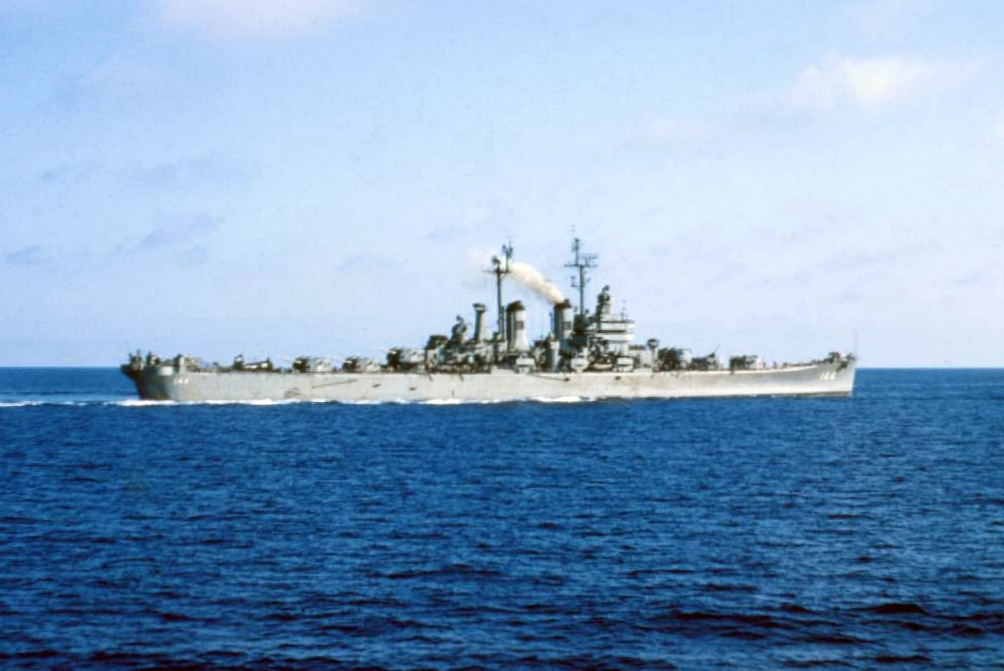
USS Worcester underway in 1953
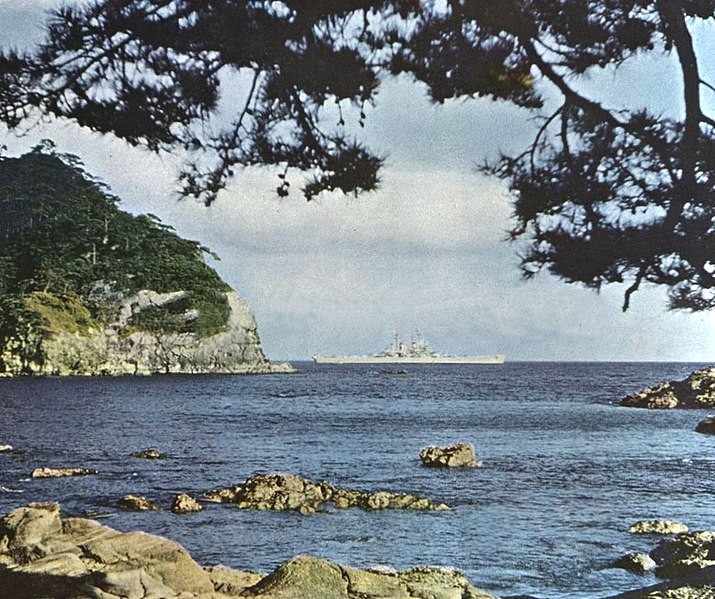
CL-144 off Shimoda, Shizuoka, 1957
She would later return to the Pacific Fleet from January 1956, 7th Fleet, visiting Sasebo and Yokosuka, Hakodate, Nagasaki, Shimoda, Yokohama, and Kobe, as well as Hong Kong, Manila until back to Long Beach for local operations. She was eventually decommissioned on 2 September 1958 at Mare Island Naval Shipyard, a process completed on 19 December, followed by a long reserve preservation at San Francisco and later Bremerton. She was eventually stricken after more than ten years in mothball, on 1 December 1970. Sold for BU to Zidell Explorations, Inc. (Portland, Oregon) on 5 July 1972.
200 tons of armor plate were later used by the Fermi National Accelerator Laboratory in Batavia, Illinois for absorption shielding. Her bell is on display at the Worcester City Hall.
 USS Vallejo (CL 146)
USS Vallejo (CL 146)
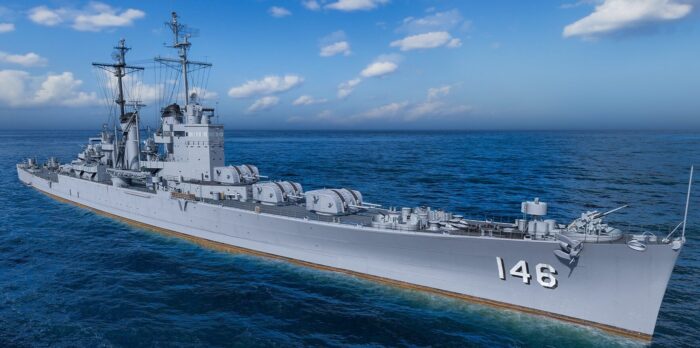
World of Warhip’s had fun imagining her in her initial 1945 design, with a different superstructures, original seaplane catapults, etc.
USS Vallejo like her sister ships was laid down at New York Shipbuilding Corporation, Camden, New Jersey on 16 July 1945 but that late, the end of the war seemed near. It ended on 15 August and her fate stayed in the balanced after substantial work had been done on her hull. Construction was suspended until officially cancelled on 8 December 1945 and she was subsequently scrapped.
As for USS Gary (CL-147), she was not even laid down when her construction was cancelled on 12 August 1945, just two days short of the Japanese capitulation.
Read More
Books
Conway’s all the world’s fighting ships 1921-47
Naval Firepower-Battlehsip Guns and Gunnery in the Dreadnought Era by Norman Friedman (2008).
The Illustrated Directory of Warships: From 1860 to the Present by David Miller (2001)
The Navy of World War II, 1922-1947 by Paul Silverstone (2012)
Rebuilding the Royal Navy: Warship Design Since 1945 by D. K. Brown and George Moore (2012)
US Navy Light Cruisers 1941-45 by Mark Stille (2016)
https://www.usni.org/press/books/us-cruisers-1
Links
https://www.ibiblio.org/hyperwar/OnlineLibrary/photos/albums/s511-cr.htm
https://www.jstor.org/stable/44890694
https://uss-la-ca135.org/
http://www.navweaps.com/Weapons/WNUS_6-47DP_mk16.php
http://www.navsource.org/archives/04/144/04144.htm
https://www.navypedia.org/ships/usa/us_cr_worcester.htm
https://www.shipscribe.com/styles/S-511/albums/s511-cr.htm
https://en.wikipedia.org/wiki/Worcester-class_cruiser
https://en.wikipedia.org/wiki/CL-154-class_cruiser
https://www.globalsecurity.org/military/systems/ship/cl-144.htm
https://www.battleships-cruisers.co.uk/worcester_class.htm
https://eugeneleeslover.com/USNAVY/CHAPTER-26-D.html
http://www.navweaps.com/Weapons/WNUS_3-50_mk27-33-34.php
https://www.navalanalyses.com/2016/10/warships-of-past-worcester-class-anti.html
Model Kits
https://www.scalemates.com/topics/topic.php?id=1211
https://sdmodelmakers.com/worcester-light-cruiser-12-inch-model.html
http://www.modelwarships.com/reviews/ships/cl/cl-144/700-amw/amw-review.html
https://www.super-hobby.com/products/USS-ROANOKE-CL-145-1957-WORCESTER-CLASS.html

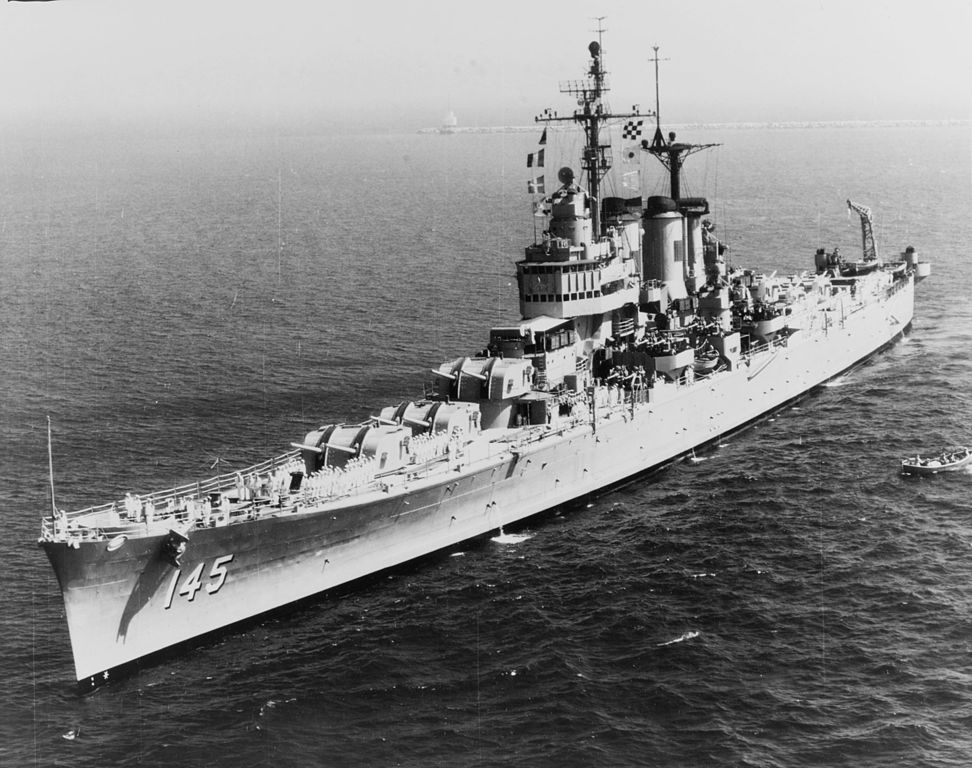




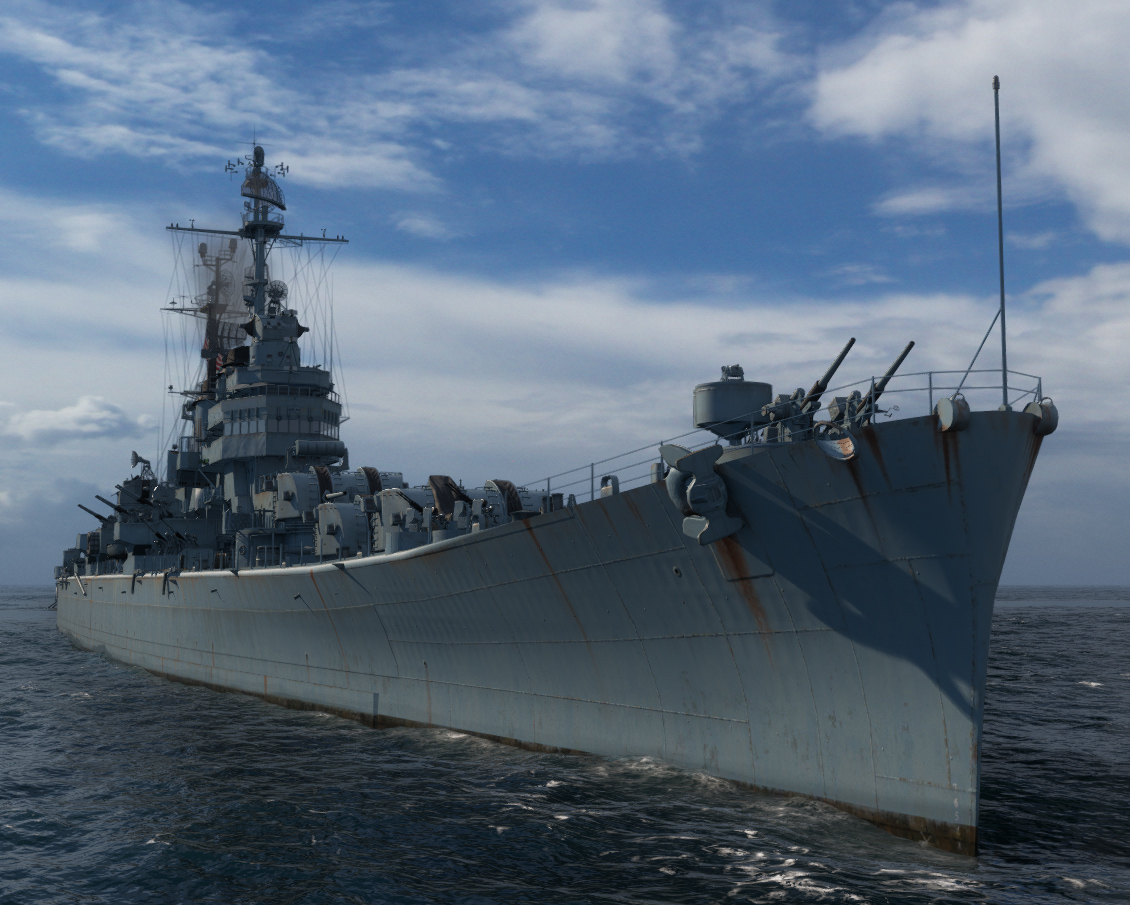
 Latest Facebook Entry -
Latest Facebook Entry -  X(Tweeter) Naval Encyclopedia's deck archive
X(Tweeter) Naval Encyclopedia's deck archive Instagram (@navalencyc)
Instagram (@navalencyc)





 French Navy
French Navy Royal Navy
Royal Navy Russian Navy
Russian Navy Armada Espanola
Armada Espanola Austrian Navy
Austrian Navy K.u.K. Kriegsmarine
K.u.K. Kriegsmarine Dansk Marine
Dansk Marine Nautiko Hellenon
Nautiko Hellenon Koninklije Marine 1870
Koninklije Marine 1870 Marinha do Brasil
Marinha do Brasil Osmanlı Donanması
Osmanlı Donanması Marina Do Peru
Marina Do Peru Marinha do Portugal
Marinha do Portugal Regia Marina 1870
Regia Marina 1870 Nihhon Kaigun 1870
Nihhon Kaigun 1870 Preußische Marine 1870
Preußische Marine 1870 Russkiy Flot 1870
Russkiy Flot 1870 Svenska marinen
Svenska marinen Søværnet
Søværnet Union Navy
Union Navy Confederate Navy
Confederate Navy Armada de Argentina
Armada de Argentina Imperial Chinese Navy
Imperial Chinese Navy Marinha do Portugal
Marinha do Portugal Mexico
Mexico Kaiserliche Marine
Kaiserliche Marine 1898 US Navy
1898 US Navy Sovietskiy Flot
Sovietskiy Flot Royal Canadian Navy
Royal Canadian Navy Royal Australian Navy
Royal Australian Navy RNZN Fleet
RNZN Fleet Chinese Navy 1937
Chinese Navy 1937 Kriegsmarine
Kriegsmarine Chilean Navy
Chilean Navy Danish Navy
Danish Navy Finnish Navy
Finnish Navy Hellenic Navy
Hellenic Navy Polish Navy
Polish Navy Romanian Navy
Romanian Navy Turkish Navy
Turkish Navy Royal Yugoslav Navy
Royal Yugoslav Navy Royal Thai Navy
Royal Thai Navy Minor Navies
Minor Navies Albania
Albania Austria
Austria Belgium
Belgium Columbia
Columbia Costa Rica
Costa Rica Cuba
Cuba Czechoslovakia
Czechoslovakia Dominican Republic
Dominican Republic Haiti
Haiti Hungary
Hungary Honduras
Honduras Estonia
Estonia Iceland
Iceland Eire
Eire Equador
Equador Iran
Iran Iraq
Iraq Latvia
Latvia Liberia
Liberia Lithuania
Lithuania Mandchukuo
Mandchukuo Morocco
Morocco Nicaragua
Nicaragua Persia
Persia San Salvador
San Salvador Sarawak
Sarawak Uruguay
Uruguay Venezuela
Venezuela Zanzibar
Zanzibar Warsaw Pact Navies
Warsaw Pact Navies Bulgaria
Bulgaria Hungary
Hungary

 Bundesmarine
Bundesmarine Dutch Navy
Dutch Navy Hellenic Navy
Hellenic Navy Marina Militare
Marina Militare Yugoslav Navy
Yugoslav Navy Chinese Navy
Chinese Navy Indian Navy
Indian Navy Indonesian Navy
Indonesian Navy JMSDF
JMSDF North Korean Navy
North Korean Navy Pakistani Navy
Pakistani Navy Philippines Navy
Philippines Navy ROKN
ROKN Rep. of Singapore Navy
Rep. of Singapore Navy Taiwanese Navy
Taiwanese Navy IDF Navy
IDF Navy Saudi Navy
Saudi Navy Royal New Zealand Navy
Royal New Zealand Navy Egyptian Navy
Egyptian Navy South African Navy
South African Navy






























 Ukrainian Navy
Ukrainian Navy dbodesign
dbodesign